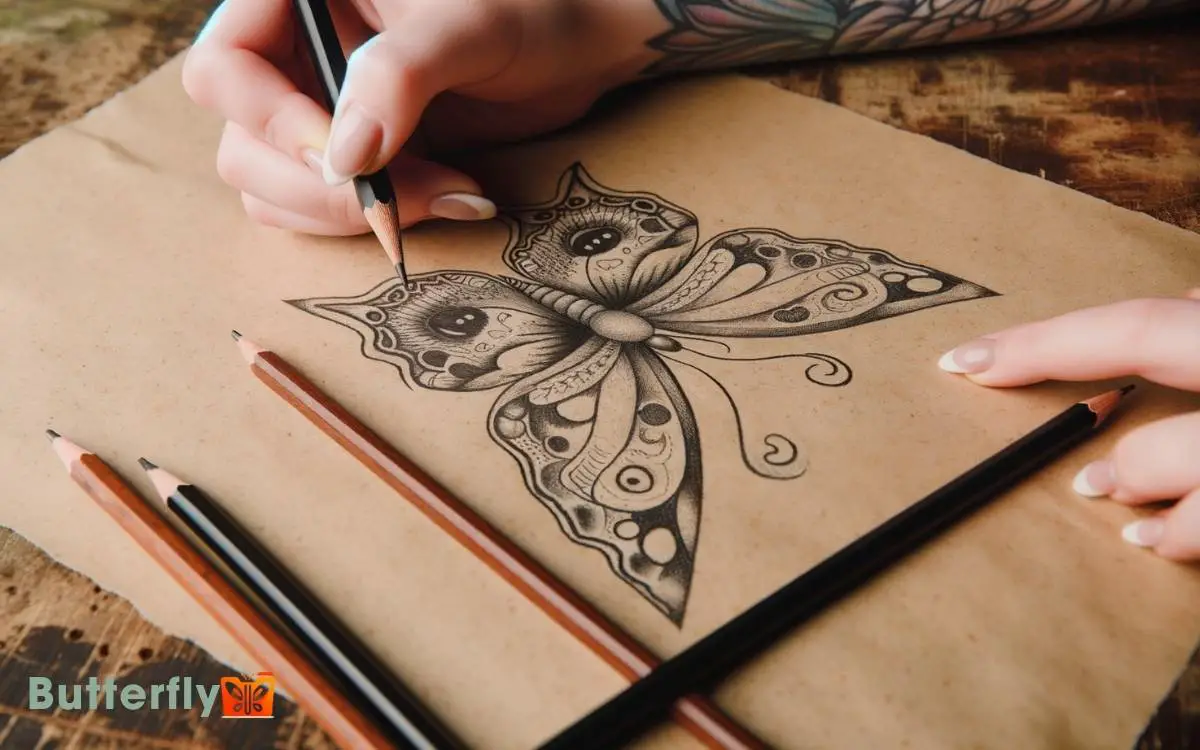How To Draw A Butterfly Tattoo? Step-by-Step Guide!
To draw a butterfly tattoo, first, choose your style realistic, abstract, watercolor, tribal, or mandala. Gather high-quality sketch paper, fine-tipped pens, pencils, and colored markers.
Start with symmetrical outlines using guideline circles for positioning. Sketch the wings and body with smooth lines, focusing on proportion and balance.
Add intricate natural-like patterns and refine with delicate points. Enhance with shading techniques like stippling, feathering, and burnishing for depth and a polished look.
Incorporate vibrant colors with smooth gradients to bring your design to life. If you want to perfect your technique, there’s much more to learn in the next steps.

Key Takeaways
Choose Your Butterfly Style
Selecting the perfect butterfly style for your tattoo involves exploring various artistic designs, from realistic depictions to abstract interpretations.
Begin by considering the symbolism you want to convey. Realistic designs capture intricate wing patterns and lifelike details, ideal for showcasing nature’s beauty.
If you’re drawn to innovation, abstract butterflies offer a playground of geometric shapes and bold lines, pushing artistic boundaries.
Watercolor styles blend colors seamlessly, creating an ethereal, dreamlike effect. You might also explore tribal or mandala designs, which infuse cultural elements and intricate patterns into your tattoo.
Gather Your Materials
Gathering your materials is an essential step that guarantees you have everything needed to bring your butterfly tattoo design to life. Start with high-quality sketch paper, which provides a sturdy canvas for your preliminary designs.
Select fine-tipped pens and pencils for detailed line work and shading opt for mechanical pencils for precision. You’ll also want colored pencils or markers to experiment with hues and gradients, capturing the vibrant essence of a butterfly.
A good eraser is vital for refining your lines without damaging the paper. Consider using a lightbox to trace and perfect your designs.
Finally, a digital tablet can be invaluable for transferring your hand-drawn concepts into a digital format, allowing for further manipulation and refinement.
Sketch Basic Shapes
Start by outlining the butterfly’s structure with a light, confident hand, focusing on symmetry. Use guideline circles to help position the body and wings accurately.
Then, define the sections of each wing, ensuring a balanced and harmonious layout.
Outline Butterfly Structure
By sketching two overlapping ovals for the wings and a slender ellipse for the body, you’ll establish the foundational structure of your butterfly tattoo.
Position the ovals symmetrically, ensuring they intersect slightly at the center where the ellipse is placed. This intersection will help you define the butterfly’s thorax and abdomen.
The upper oval should be larger, representing the forewings, while the lower one, smaller, outlines the hindwings. Keep your lines light and fluid, embracing the organic symmetry that butterflies naturally exhibit.
As you refine the shapes, pay attention to the gentle curves and subtle angles that give the wings their delicate, intricate appearance. This precise framework will guide you through the more detailed phases of your tattoo design.
Add Guideline Circles
To enhance the structure, incorporate guideline circles at key points on the wings and body to map out the intricate patterns and shapes of your butterfly tattoo.
- Start by placing a central circle for the body, ensuring it’s proportionate.
- Next, sketch smaller circles on the upper and lower wings to define the primary sections. These circles will act as anchors for your design, helping you balance symmetry and detail.
- Use these guidelines to align decorative elements, such as spots and lines, ensuring they flow naturally with the butterfly’s form.
Define Wing Sections
Almost instinctively, you’ll begin defining the wing sections by sketching basic shapes that capture the butterfly’s elegant symmetry and fluidity.
Visualize the butterfly’s anatomy by breaking down the wings into:
- Upper wing lobes: Crescent shapes that extend outward and upward.
- Lower wing lobes: Teardrop forms that taper downwards.
- Central vein structures: Lightly sketched lines that radiate from the butterfly’s body to the wing tips.
- Connecting arcs: Smooth, flowing curves linking the upper and lower sections.
These foundational shapes will guide your detailing, ensuring precision and balance in your butterfly tattoo design.
Outline The Wings
Start by sketching the outer edges of the wings with smooth, flowing lines to capture the natural elegance of a butterfly in flight.
Use a light hand to outline the upper and lower wings, ensuring the curves mirror each other for symmetry. Focus on the organic shapes; each wing should arch gracefully, tapering into delicate points.
Don’t rush this step precision here sets the stage for the entire tattoo. Give attention to the slight variations in the wing’s perimeter, reflecting a lifelike appearance.
Maintain a balanced proportion between the top and bottom wings for a cohesive look. Your lines should evoke a sense of motion, as if the butterfly could flutter away at any moment.
Add Wing Patterns
Now that the wings are outlined, enhance their beauty by intricately designing patterns that mimic the delicate textures found in nature.
Consider these elements:
- Spirals and swirls: Add flowing, curved lines to give a sense of movement and grace.
- Geometric shapes: Incorporate triangles, diamonds, and hexagons for a modern, innovative look.
- Dots and stippling: Use clusters of dots to create shading and depth, adding a tactile feel.
- Natural motifs: Include floral patterns or leaf-like designs to enhance organic beauty.
Experiment with combinations, balancing detail with simplicity to create an eye-catching, harmonious design.
Draw The Body
Focusing on the butterfly’s body, sketch a slender, segmented torso that serves as the central anchor for the wings. Begin by drawing a slightly curved line to establish the spine.
Divide this line into three distinct segments: the head, thorax, and abdomen. The head should be small and rounded, followed by a wider, robust thorax. The abdomen tapers off elegantly, giving an impression of delicacy and grace.
Make sure the segments are proportionate to maintain balance within the design. Add subtle lines to indicate the segmentation and enhance the textural depth.
This body won’t only provide structural stability to your butterfly but will also add a touch of realism and intricacy, essential for an innovative and striking tattoo.
Refine The Details
With the body structure in place, refine the details by enhancing the butterfly’s antennae, adding intricate patterns to the wings, and accentuating the texture of the segments.
Carefully draw the antennae with delicate, flowing lines that suggest movement. Focus on the wings by incorporating:
- Geometric shapes: Integrate triangles and diamonds to create a modern, dynamic look.
- Organic patterns: Add swirls and curves for an elegant, natural feel.
- Symmetry: Guarantee both wings mirror each other perfectly for balance.
- Textures: Use cross-hatching to give depth to the segments.
These enhancements will make your butterfly tattoo stand out with a unique blend of complexity and artistry, capturing both the essence of nature and innovative design.
Add Shading Techniques
To bring your butterfly tattoo to life, focus on mastering light and dark contrast to create depth and dimension.
Use smooth gradient blending to shift seamlessly between shades, highlighting the delicate intricacies of the wings.
These techniques will add realism and a dynamic feel to your artwork.
Light and Dark Contrast
Mastering light and dark contrast in your butterfly tattoo involves understanding and applying various shading techniques to create depth and dimension. Start by identifying the light source to determine where shadows and highlights will fall.
- Cross-hatching: Use intersecting lines to build intense shadows.
- Stippling: Apply dots closer together for darker areas, spreading them out for lighter ones.
- Feathering: Create soft blends by lightening your pressure as you move away from dark regions.
- Burnishing: Use a colorless blender to smooth out shaded areas, giving a polished look.
Smooth Gradient Blending
Achieving a smooth gradient blend in your butterfly tattoo involves meticulously shifting between shades to create a seamless flow of color. Begin by selecting your primary colors.
Use light, feathered strokes to shift smoothly from one hue to the next. Layering is key start with the lightest shade and gradually introduce darker tones.
Pay close attention to the pressure you apply; softer strokes help merge colors organically. A circular motion can further soften the edges, ensuring no harsh lines disrupt the gradient.
Don’t rush take your time to build the depth and richness of the gradient. Experiment with different tools such as blending stumps or soft brushes to achieve that perfect, innovative look that breathes life into your butterfly tattoo.
Incorporate Color
When incorporating color into your butterfly tattoo design, start by selecting a harmonious palette that enhances the natural beauty and intricate details of the wings.
Consider the following elements:
- Gradient shifts: Seamlessly blend hues from the central body to the wingtips to create a mesmerizing ombre effect.
- Contrasting shades: Use complementary colors to accentuate patterns and add visual depth.
- Highlighting accents: Apply lighter tones on the edges or near vein structures to mimic natural light reflections.
- Darkened outlines: Define edges with darker shades to provide a striking contrast and emphasize the overall shape.
Review And Adjust
Once you’ve applied your chosen colors, take a step back to carefully evaluate the overall composition and balance of your butterfly tattoo design.
Examine the harmony between the wings, body, and antennae. Are the colors blending seamlessly or clashing? Look for any disproportionate elements that might disrupt the symmetry.
Pay attention to the shading does it create a realistic three-dimensional effect? Assess the line work; it should be clean and crisp, enhancing the intricate details. Adjust any uneven areas by refining lines or tweaking color gradients.
Practice And Perfect
To truly master the art of drawing butterfly tattoos, you need to immerse yourself in consistent practice, refining your technique with each attempt. Focus on the subtleties that make each butterfly unique.
Pay attention to:
- Wing Patterns: Experiment with symmetrical and asymmetrical designs to create visual dynamism.
- Shading: Use gradients to add depth, making the wings appear delicate and lifelike.
- Antennae and Legs: Perfect the fine details to provide realism and intricate beauty.
- Color Blending: Practice blending different hues to achieve vibrant, eye-catching effects.
Each drawing session should push your boundaries, encouraging innovative approaches and techniques. Use high-quality materials and reference real butterflies for inspiration.
Conclusion
You’ve now transformed blank paper into a vibrant butterfly tattoo. By juxtaposing bold outlines with delicate shading, you’ve crafted a piece that merges strength and grace.
The intricate patterns and vivid colors breathe life into your creation. As you review and adjust, remember that each tweak enhances the beauty.
Practice and perfect your technique, and soon you’ll be capturing the ephemeral elegance of butterflies with ease. Your artistic journey is just beginning, and the canvas is yours to conquer. With patience and dedication, you’ll develop your own unique style, bringing these delicate creatures to life on the page. Exploring different tutorials and resources on how to draw butterflies will help refine your skills and boost your confidence. Keep experimenting with colors and compositions, and let your creativity take flight.






